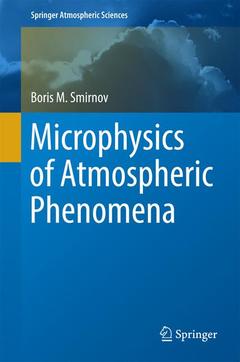Description
Microphysics of Atmospheric Phenomena, 1st ed. 2017
Springer Atmospheric Sciences Series
Author: Smirnov Boris M.
Language: English
Subject for Microphysics of Atmospheric Phenomena:
Approximative price 126.59 €
In Print (Delivery period: 15 days).
Add to cartSupport: Print on demand
Description
/li>Contents
/li>Biography
/li>Comment
/li>
This book investigates elementary processes in the Earth?s atmosphere involving photons, electrons, ions, radicals, and aerosols. It is based on global atmospheric models such as the standard atmospheric model with averaged atmospheric parameters across the globe and over time, the Earth?s energetic balance, and the global electric circuit that allows to analyze fundamental atmospheric properties to be analyzed. Rate constants of elementary processes in the Earth?s atmosphere, together with measured atmospheric parameters and existing concepts of atmospheric phenomena, are used in the analysis of global and local atmospheric processes. Atmospheric photoprocesses result from the interaction of solar radiation with the atmosphere and processes involving ions, oxygen atoms, excited atomic particles and ozone molecules. Atmospheric electricity as a secondary phenomenon to atmospheric water circulation results in a chain of processes that begins with collisions of water aerosols in different aggregate states. Cosmic rays are of importance for atmospheric electricity, as they create positive and negative ions in the air. Air breakdown in an electric field of clouds in the form of lightning may develop under the influence of cosmic ray-created seed electrons, which are necessary for electron multiplication in ionization wave-streamers. The upper atmosphere (ionosphere) is formed under solar radiation in a vacuum ultraviolet spectrum, and absorption of this radiation leads to air photoionization. The greenhouse effect is determined by atmospheric water, whereas transitions between a water vapor and aerosols may lead to a change in atmospheric optical depth. Carbon dioxide contributes in small portions to the atmospheric greenhouse effect. Cosmic rays are of importance for atmospheric discharge, the origin of lightning and cloud formation in the first stage of aerosol growth. This book provides a qualitative description of atmospheric properties and phenomena based on elementary processes and simple models.
Part 1 - Fundamentals of atmosphere and atmospheric processes.- Properties of neutral atmosphere.- Charged particles in atmosphere.- Electric processes in atmosphere.- Part 2 - Elementary and transport atmospheric processes.- Electron processes in atmospheric air.- Ion processes in atmospheric air.- Processes in dissociated air.- Atmospheric processes involving aerosols.- Part 3 - Radiative processes in the earth.- Photoionization atmospheric processes.- Infrared atmospheric emission.- Local atmospheric photo-processes.
Boris Smirnov was born in 1938 in Moscow. In 1962 he graduated from Moscow's Engineering-Physical Institute in Theoretical Nuclear Physics. He got the dissertation of Candidate of Phys. Mat. Science in 1964, and Doctor of Phys. Mat. Science in 1968. He became a Professor of Physics in 1970. In the years 1962-1982 he was Head of Laboratory at Kurchatov Institute of Atomic Energy (Moscow), from 1982-1986 Head of Laboratory at Institute of Thermophysics (Novosibirsk) and from 1986 Head of Laboratory, Head of Department and now Principal Scientific at Joint Institute for High Temperatures of Russian Academy of Science. B.M. Smirnov was a member of the editorial Board of several journals of various publishers. He was Professor of the Moscow Power Institute, Novosibirsk, State University and the Moscow Institute of Science and Technology. He was a laureate of the National Prize of Russia. His research is focused on Theoretical Physics, Atomic, Molecular, Cluster, Plasma and Chemical Physics. He is author of 53 books and about 500 papers.
Relates elementary processes to globally measured atmospheric parameters to provide a deeper understanding of atmospheric processes and phenomena
Analyzes the chain of processes of atmospheric electricity as a secondary phenomenon of water circulation in the atmosphere
Explores the fundamental atmospheric constituents contributing to the greenhouse effect
Also suitable as a textbook for students of meteorology and atmospheric physics
Includes supplementary material: sn.pub/extras




